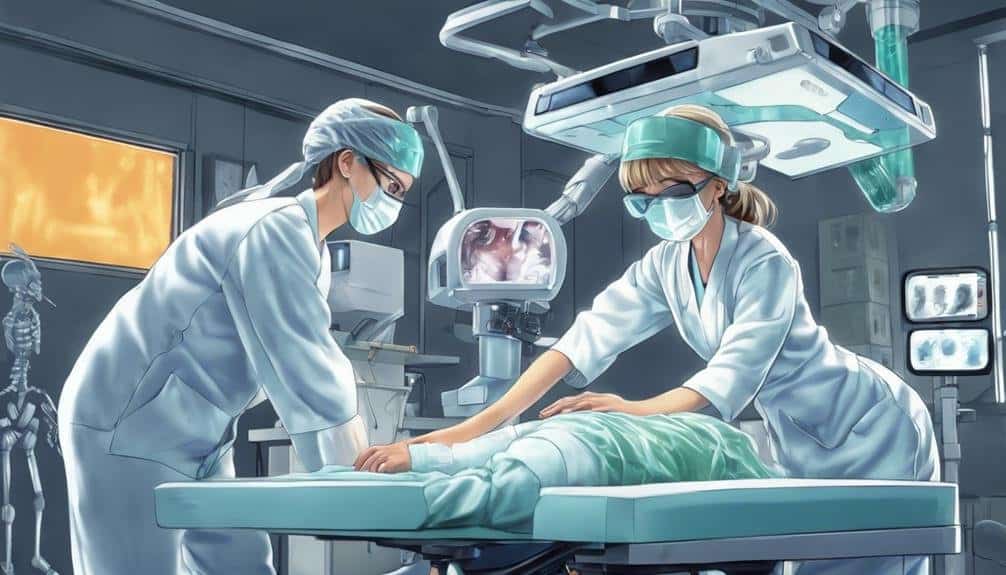Job Duties for Radiologic Technologist
Radiologic technologists play a vital role in the healthcare field by performing a variety of essential duties. From operating X-ray machines to collaborating with the healthcare team, their responsibilities encompass a wide range of tasks.
However, there is one aspect of their job that often goes unnoticed but is equally important. This particular duty requires a keen eye for detail and a high level of technical skill. It involves more than just pressing buttons and capturing images—it requires a delicate balance between precision and compassion.
Key Takeaways
- Expertise in operating X-ray machines and adherence to safety protocols.
- Proficient patient care skills and precise positioning techniques.
- Clear communication and collaboration with healthcare professionals.
- Diligent equipment maintenance, safety practices, and accurate record-keeping.
Operating X-Ray Machines
Operating X-Ray Machines requires a high level of technical proficiency and adherence to strict safety protocols in order to produce accurate diagnostic images. Radiologic technologists must guarantee machine maintenance is regularly performed to guarantee peak performance and image quality. This includes calibrating equipment, conducting quality control checks, and promptly addressing any malfunctions to prevent image artifacts that could compromise diagnostic accuracy.
Radiologic technologists must also adhere to radiation safety guidelines and exposure limits to minimize risks to both patients and themselves. This involves using lead aprons, thyroid shields, and other protective gear, as well as minimizing exposure time and maximizing distance from the radiation source. Technologists must also follow ALARA (As Low As Reasonably Achievable) principles to keep radiation doses as low as possible while still obtaining the necessary diagnostic information.
Preparing Patients for Procedures
Ensuring best patient positioning techniques is fundamental in radiologic technology to obtain accurate imaging results. Radiologic technologists play a critical role in guaranteeing patient comfort throughout the procedure, fostering a positive patient experience.
Attention to detail in patient preparation is essential for successful imaging and overall patient care.
Patient Positioning Techniques
Utilizing precise anatomical knowledge and meticulous attention to detail, radiologic technologists employ strategic patient positioning techniques to prepare individuals for medical imaging procedures.
- Maintaining Alignment: Ensuring the patient is correctly aligned on the imaging table to capture accurate images.
- Minimizing Movement: Instructing patients on staying still during the procedure to avoid blurriness in the images.
- Shielding Sensitive Areas: Placing lead shields over reproductive organs or other sensitive areas to adhere to radiation safety protocols.
These techniques not only contribute to the quality of the images produced but also play a significant role in ensuring patient comfort and safety by minimizing radiation exposure and enhancing the overall patient care experience.
Ensuring Patient Comfort
With a focus on enhancing patient experience and ensuring high-quality imaging results, radiologic technologists meticulously prepare patients for procedures by prioritizing their comfort and well-being. Effective patient communication and implementing comfort measures are essential components of this process. Prior to the imaging procedure, radiologic technologists explain the steps involved, address any concerns the patient may have, and make sure they are informed and comfortable throughout the process. Comfort measures such as providing warm blankets, adjusting the lighting for a calming atmosphere, and offering support during positioning help alleviate patient anxiety and enhance their overall experience. By fostering a caring and supportive environment, radiologic technologists play a pivotal role in making sure patients feel at ease and receive high-quality care.
| Comfort Measures | Description | Benefits |
|---|---|---|
| Patient Education | Explain the procedure steps and address patient concerns. | Reduce anxiety and increase compliance |
| Warm Blankets | Offer warm blankets to enhance patient comfort during the procedure. | Promote relaxation and warmth |
| Lighting Adjustment | Adjust room lighting to create a calming atmosphere for the patient. | Enhance comfort and reduce stress |
| Positioning Support | Provide assistance and support to ensure the patient is comfortably positioned for imaging. | Prevent discomfort and improve imaging quality |
| Communication | Maintain open communication with the patient to address any needs or concerns. | Build trust and enhance patient experience |
Positioning Patients for Imaging
Proper patient positioning is essential in radiologic technology to guarantee accurate imaging results. When positioning patients for imaging procedures, radiologic technologists must prioritize patient comfort while adhering to strict safety protocols.
Here are three key points to contemplate:
- Communication: Before positioning the patient, clear communication is vital. Explaining the procedure, discussing what is expected from the patient, and addressing any concerns can help alleviate anxiety and assure cooperation during the process.
- Alignment: Precise alignment is critical for obtaining clear images. Technologists must carefully position the patient according to the specific imaging requirements to capture accurate diagnostic information.
- Safety Measures: Implementing safety protocols such as using immobilization devices, protective shields, and ensuring proper support can prevent patient movement and minimize radiation exposure, contributing to a safe imaging environment.
Ensuring Image Quality
To guarantee the accuracy and reliability of diagnostic imaging results, radiologic technologists must meticulously assess and optimize image quality through adherence to established protocols and technical standards. Image interpretation is a critical aspect of their role, requiring a keen eye for detail to identify any anomalies or artifacts that could affect the diagnostic value of the images. Quality control measures are implemented to make certain that images meet the necessary standards for clarity and precision.
Radiation safety is paramount in the field of radiologic technology. Technologists must follow strict guidelines to minimize patient and staff exposure to radiation. Exposure monitoring is conducted regularly to track radiation doses and make certain they are within safe limits. By maintaining a focus on radiation safety, technologists contribute to a safer healthcare environment for both patients and healthcare professionals.
Collaborating With Healthcare Team
Collaborating with the healthcare team is an essential aspect of a radiologic technologist's role. It involves working closely with radiologists, physicians, nurses, and other healthcare professionals to guarantee excellent patient care.
Effective communication and collaboration are essential for accurate diagnosis and treatment planning.
Teamwork in Healthcare
Working harmoniously with the healthcare team is essential for radiologic technologists to guarantee efficient patient care and accurate diagnostic imaging services. This involves understanding teamwork dynamics and actively participating in interprofessional collaboration.
Radiologic technologists must:
- Communicate effectively with other healthcare professionals to make sure seamless patient care.
- Collaborate with radiologists to review imaging results and provide accurate diagnoses.
- Support colleagues by assisting during procedures and maintaining a safe environment for patients and staff.
Communication and Collaboration
Fostering effective communication and collaboration within the healthcare team is paramount for radiologic technologists to guarantee seamless patient care and accurate diagnostic outcomes. Radiologic technologists must communicate clearly with other healthcare professionals, such as radiologists, nurses, and referring physicians, to make sure that patient needs are met efficiently. Effective communication involves actively listening, providing and receiving feedback, and sharing critical information in a timely manner.
Following Safety Protocols
Adhering to strict safety protocols is a fundamental responsibility for radiologic technologists in order to safeguard the well-being of patients and staff. Following safety measures and minimizing radiation exposure are critical aspects of the job to guarantee the highest level of care and protection for all individuals involved.
- Proper Use of Protective Gear: Radiologic technologists must consistently wear lead aprons, gloves, and thyroid shields to shield themselves from radiation exposure during imaging procedures.
- Maintaining Radiation Protection: Ensuring that all radiation-emitting equipment is properly calibrated and regularly inspected is essential for reducing unnecessary radiation exposure to patients and staff.
- Implementing Safe Practices: Adhering to established safety protocols such as maintaining a safe distance from the radiation source, limiting exposure time, and using shielding devices whenever possible are key components of ensuring a safe environment for all.
Maintaining Equipment
Ensuring the proper maintenance of radiologic equipment is essential for the utmost functionality and accuracy of imaging procedures in the healthcare setting. Radiologic technologists are responsible for adhering to equipment maintenance schedules to guarantee best performance and adherence to safety protocols. Regular maintenance tasks include calibrating machines, inspecting for wear and tear, and promptly addressing any malfunctions to minimize downtime and ensure equipment operation meets industry standards.
Proper equipment operation is vital not only for producing high-quality images but also for ensuring patient safety. Radiologic technologists must be proficient in operating various radiologic equipment to facilitate accurate imaging procedures while prioritizing patient care. By maintaining equipment in top condition, technologists contribute to efficient workflows, timely diagnoses, and overall patient well-being.
Documenting Patient Information
Proper documentation of patient information is a vital aspect of the responsibilities undertaken by radiologic technologists in the healthcare setting. It plays an important role in ensuring patient confidentiality, record keeping, documentation accuracy, and legal compliance.
Here are three key points related to documenting patient information:
- Patient Confidentiality: Radiologic technologists must adhere to strict guidelines to maintain patient confidentiality. This includes safeguarding patient records, only sharing information with authorized individuals, and ensuring that sensitive data is protected at all times.
- Record Keeping: Accurate record keeping is essential for tracking patient history, treatment plans, and outcomes. Radiologic technologists must meticulously document all procedures, observations, and patient interactions to provide a thorough overview of each individual's healthcare journey.
- Documentation Accuracy, Legal Compliance: Ensuring the accuracy of patient information is important for delivering quality care and maintaining legal compliance. Radiologic technologists must follow standardized protocols for documenting data, report findings accurately, and comply with regulations to uphold the integrity of medical records.
Providing Patient Care
In the domain of radiologic technology, a fundamental aspect of the role involves tending to the needs and well-being of patients through the provision of dedicated care and support. Radiologic technologists engage in direct patient interaction, requiring a compassionate bedside manner to alleviate anxiety and guarantee patient comfort throughout procedures. Establishing rapport with patients is essential for fostering cooperation and obtaining accurate imaging results.
Additionally, radiologic technologists are responsible for adhering to radiation safety protocols and employing various protection techniques to minimize patient exposure to radiation. This includes using lead aprons, shields, and collimation to safeguard vulnerable areas of the body from unnecessary radiation exposure. By meticulously following these safety measures, technologists demonstrate their commitment to prioritizing patient well-being and maintaining high standards of care.
Continuing Education and Training
Regularly updating skills and knowledge through ongoing education and training is imperative for radiologic technologists to stay abreast of advancements in the field and provide excellent patient care. Continuing education allows professionals to enhance their abilities, learn about new technologies, and maintain compliance with industry standards.
Here are some key ways radiologic technologists can engage in continuing education and training:
- Online Courses: Completing online courses offers flexibility and convenience, allowing technologists to learn at their own pace and schedule. These courses cover a wide range of topics from new imaging techniques to radiation safety protocols.
- Certifications: Pursuing specialized certifications demonstrates a commitment to excellence and can lead to career advancement opportunities. Certifications such as MRI or CT scan can expand the technologist's skill set and increase their marketability.
- Hands-on Workshops, Seminars: Participating in hands-on workshops and seminars provides valuable practical experience and networking opportunities. These events offer a platform to interact with industry experts, share best practices, and gain insights into the latest trends in radiologic technology.
Conclusion
To sum up, the job duties of a radiologic technologist are diverse and essential in the healthcare field. Like a conductor leading a symphony, radiologic technologists orchestrate the imaging process with precision and expertise. By operating X-ray machines, preparing patients, ensuring image quality, and collaborating with the healthcare team, they play a critical role in diagnosing and treating patients.
Continuing education and maintenance of equipment are necessary for upholding standards of care and patient safety.







